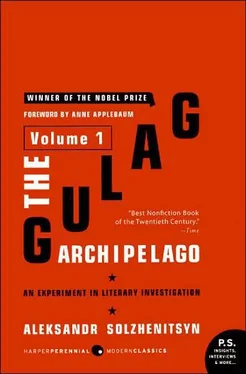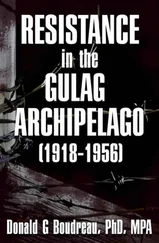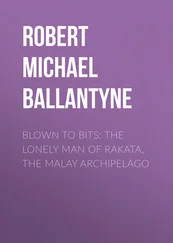Aleksandr Solzhenitsyn - The GULag Archipelago Volume 1 - An Experiment in Literary Investigation
Здесь есть возможность читать онлайн «Aleksandr Solzhenitsyn - The GULag Archipelago Volume 1 - An Experiment in Literary Investigation» весь текст электронной книги совершенно бесплатно (целиком полную версию без сокращений). В некоторых случаях можно слушать аудио, скачать через торрент в формате fb2 и присутствует краткое содержание. Город: New York, Год выпуска: 2007, ISBN: 2007, Издательство: Harper Perennial Modern Classics, Жанр: История, Биографии и Мемуары, dissident, на английском языке. Описание произведения, (предисловие) а так же отзывы посетителей доступны на портале библиотеки ЛибКат.
- Название:The GULag Archipelago Volume 1: An Experiment in Literary Investigation
- Автор:
- Издательство:Harper Perennial Modern Classics
- Жанр:
- Год:2007
- Город:New York
- ISBN:9780061253713
- Рейтинг книги:3 / 5. Голосов: 1
-
Избранное:Добавить в избранное
- Отзывы:
-
Ваша оценка:
- 60
- 1
- 2
- 3
- 4
- 5
The GULag Archipelago Volume 1: An Experiment in Literary Investigation: краткое содержание, описание и аннотация
Предлагаем к чтению аннотацию, описание, краткое содержание или предисловие (зависит от того, что написал сам автор книги «The GULag Archipelago Volume 1: An Experiment in Literary Investigation»). Если вы не нашли необходимую информацию о книге — напишите в комментариях, мы постараемся отыскать её.
“Best Nonfiction Book of the Twentieth Century” (Time magazine ) Review
The GULag Archipelago Volume 1: An Experiment in Literary Investigation — читать онлайн бесплатно полную книгу (весь текст) целиком
Ниже представлен текст книги, разбитый по страницам. Система сохранения места последней прочитанной страницы, позволяет с удобством читать онлайн бесплатно книгу «The GULag Archipelago Volume 1: An Experiment in Literary Investigation», без необходимости каждый раз заново искать на чём Вы остановились. Поставьте закладку, и сможете в любой момент перейти на страницу, на которой закончили чтение.
Интервал:
Закладка:
It is really hard to see why we condemn the Inquisition. Wasn’t it true that beside the autos-da-fe, magnificent services were offered the Almighty? It is hard to see why we are so down on serfdom. After all, no one forbade the peasants to work every day. And they could sing carols at Christmas too. And for Trinity Day the girls wove wreaths….
The exceptional character which written and oral legend nowadays assigns to the year 1937 is seen in the creation of fabricated charges and tortures. But this is untrue, wrong. Throughout the years and decades, interrogations under Article 58 were almost never undertaken to elicit the truth, but were simply an exercise in an inevitably filthy procedure: someone who had been free only a little while before, who was sometimes proud and always unprepared, was to be bent and pushed through a narrow pipe where his sides would be torn by iron hooks and where he could not breathe, so that he would finally pray to get to the other end. And at the other end, he would be shoved out, an already processed native of the Archipelago, already in the promised land. (The fool would keep on resisting! He even thought there was a way back out of the pipe.)
The more time that passes without anything being written about all this, the harder it becomes to assemble the scattered testimony of the survivors. But they tell us that the creation of fabricated cases began back in the early years of the Organs so their constant salutary activity might be perceived as essential. Otherwise, what with a decline in the number of enemies, the Organs might, in a bad hour, have been forced to wither away. As the case of Kosyrev makes clear, [53] 3. Cf. Part I, Chapter 8, below.
the situation of the Cheka was shaky even at the beginning of 1919. Reading the newspapers of 1918, I ran into the official report of a terrible plot that had just been discovered: A group of ten people wanted to (it seems they only wanted to!) drag cannon onto the roof of an orphanage (let’s see—how high was it?) and shell the Kremlin. There were ten of them (including, perhaps, women and youngsters), and it was not reported how many cannon there were to be—nor where the cannon were to come from. Nor what caliber they were. Nor how they were to be carried up the stairs to the attic. Nor how they were to be set up, on the steeply sloping roof, and so they wouldn’t recoil when fired! How was it that the Petersburg police, when they were fighting to put down the February Revolution, took nothing heavier than a machine gun up to the roofs? Yet this fantasy, exceeding even the fabrications of 1937, was read and believed! Apparently, it will be proved to us in time that the Gumilyev case of 1921 was also fabricated. [54] 4. A. A. Akhmatova told me she was convinced that this was so. She even gave me the name of the Chekist who cooked up the case—Y. Agranov, it seems.
In that same year, 1921, the Ryazan Cheka fabricated a false case of a “plot” on the part of the local intelligentsia. But the protests of courageous people could still reach Moscow, and they dropped the case. That year, too, the whole Sapropelite Committee, part of the Commission on the Use of Natural Forces, was shot. Familiar enough with the attitude and the mood of Russian scientists at that time, and not being shut off from those years by a smoke screen of fanaticism, we can, indeed, figure out, even without archaeological excavations, the precise validity of that case.
Here is what Y. Doyarenko remembers about 1921: the Lubyanka reception cell for those newly arrested, with forty to fifty trestle beds, and women being brought in one after another all night long. None of them knew what she was supposed to be guilty of, and there was a feeling among them that people were being arrested for no reason at all. Only one woman in the whole cell knew why she was there—she was an SR. The first question asked by Yagoda: “Well, what are you here for?” In other words, you tell me, and help me cook up the case! And they say absolutely the same thing about the Ryazan GPU in 1930! People all felt they were being imprisoned for no reason. There was so little on which to base a charge that they accused I. D. T-v of using a false name. (And even though his name was perfectly real, they handed him three years via a Special Board—OSO—under 58-10.) Not knowing what to pick on, the interrogator asked: “What was your job?” Answer: “A planner.” The inter-rogater: “Write me a statement that explains ‘planning at the factory and how it is carried out.’ After that I will let you know why you’ve been arrested.” (He expected the explanation to provide the hook on which to hang a charge.)
Here is the way it went in the case of the Kovno Fortress in 1912: Since the fortress served no useful military purpose, it was decided to eliminate it. At that point the fortress command, thoroughly alarmed, arranged a “night attack” simply to prove its usefulness and in order to stay where they were!
The theoretical view of the suspect’s guilt was, incidentally, quite elastic from the very beginning. In his instructions on the use of Red Terror, the Chekist M. I. Latsis wrote: “In the interrogation do not seek evidence and proof that the person accused acted in word or deed against Soviet power. The first questions should be: What is his class, what is his origin, what is his education and upbringing? [There is your Sapropelite Committee for you!] These are the questions which must determine the fate of the accused.” On November 13, 1920, Dzerzhinsky reported in a letter to the Cheka that “slanderous declarations are often given the green light” in the Cheka.
After so many decades have they not taught us that people do not return from there? Except for the small, brief, intentional reverse wave of 1939, one hears only the rarest, isolated stories of someone being turned loose as the result of an interrogation. And in such cases, the person was either imprisoned soon again or else he was let out so he could be kept under surveillance. That is how the tradition arose that the Organs do not make mistakes. Then what about those who were innocent?
In his Dictionary of Definitions Dal makes the following distinction: “An inquiry is distinguished from an investigation by the fact that it is carried out to determine whether there is a basis for proceeding to an investigation.”
On, sacred simplicity! The Organs have never heard of such a thing as an inquiry! Lists of names prepared up above, or an initial suspicion, or a denunciation by an informer, or any anonymous denunciation, [55] 5. Article 93 of the Code of Criminal Procedure has this to say: “An anonymous declaration can serve as reason for beginning a criminal case”! (And there is no need to be surprised at the word “criminal” here, since all “politicals” were considered criminals, too, under the Code.)
were all that was needed to bring about the arrest of the suspect, followed by the inevitable formal charge. The time allotted for investigation was not used to unravel the crime but, in ninety-five cases out of a hundred, to exhaust, wear down, weaken, and render helpless the defendant, so that he would want it to end at any cost.
As long ago as 1919 the chief method used by the interrogator was a revolver on the desk. That was how they investigated not only political but also ordinary misdemeanors and violations. At the trial of the Main Fuels Committee (1921), the accused Makhrovskaya complained that at her interrogation she had been drugged with cocaine. The prosecutor replied: “If she had declared that she had been treated rudely, that they had threatened to shoot her, this might be just barely believable.” [56] 6. N. V. Krylenko, Za Pyat Let (1918-1922) (The Last Five Years [1918-1922]), Moscow-Petrograd, GIZ, 1923, p. 401.
The frightening revolver lies there and sometimes it is aimed at you, and the interrogator doesn’t tire himself out thinking up what you are guilty of, but shouts: “Come on, talk! You know what about!” That was what the interrogator Khaikin demanded of Skripnikova in 1927. That was what they demanded of Vitkovsky in 1929. And twenty-five years later nothing had changed. In 1952 Anna Skripnikova was undergoing her fifth imprisonment, and Sivakov, Chief of the Investigative Department of the Ordzhonikidze State Security Administration, said to her: “The prison doctor reports you have a blood pressure of 240/120. That’s too low, you bitch! We’re going to drive it up to 340 so you’ll kick the bucket, you viper, and with no black and blue marks; no beatings; no broken bones. We’ll just not let you sleep.” She was in her fifties at the time. And if, back in her cell, after a night spent in interrogation, she closed her eyes during the day, the jailer broke in and shouted: “Open your eyes or I’ll haul you off that cot by the legs and tie you to the wall standing up.”
Интервал:
Закладка:
Похожие книги на «The GULag Archipelago Volume 1: An Experiment in Literary Investigation»
Представляем Вашему вниманию похожие книги на «The GULag Archipelago Volume 1: An Experiment in Literary Investigation» списком для выбора. Мы отобрали схожую по названию и смыслу литературу в надежде предоставить читателям больше вариантов отыскать новые, интересные, ещё непрочитанные произведения.
Обсуждение, отзывы о книге «The GULag Archipelago Volume 1: An Experiment in Literary Investigation» и просто собственные мнения читателей. Оставьте ваши комментарии, напишите, что Вы думаете о произведении, его смысле или главных героях. Укажите что конкретно понравилось, а что нет, и почему Вы так считаете.












